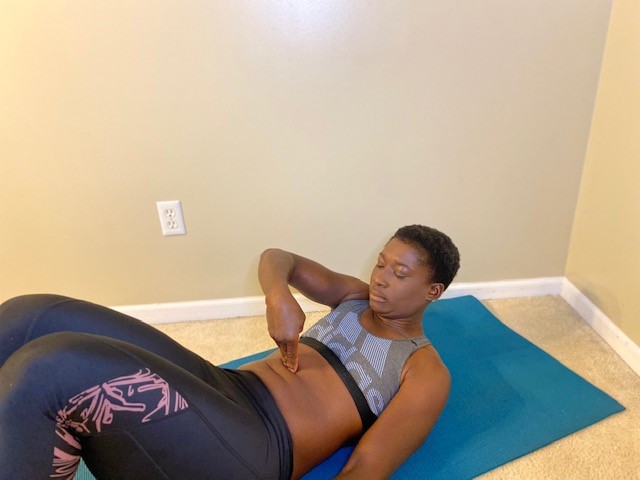Is it a mommy belly or something else?
Like some mommies on this platform, getting back to pre-baby shape has been an on-going and difficult feat. I am the mother of two young boys and one older step-daughter. I gained 42 lbs. with each pregnancy which was not only a lot to carry but more so, difficult for me to accept as prior to this I was a workout queen. I worked out 6 days a week and was once a natural professional figure competitor. I knew how to eat clean and I understood what types of exercises I needed for my body type yet, I still managed to gain the weight and have not seen my abs almost three years after baby number 2.
But this blog post isn’t about me. It is in response to the multiple women who commented during our Mommination IG live welcome party to start the #fitmommichallenge. I am a physical therapist (PT) with 16 years of experience specializing in orthopedic conditions. Many of my patients have low back pain and about 9 years ago, I started paying attention to and screening for diastasis recti in women who had children and back pain.
Many of them would inform me of back or hip pain during pregnancy or shortly after giving birth that never went away. Some would only have pain with exercises or when doing strenuous work around the house. Others would say “I work out all the time but I can’t get rid of this belly after I had my kids”. Does any of this sound familiar? Even though I don’t have a “true” diastasis recti, I do have a slight separation that makes me empathetic to the difficulty in losing the mommy belly but also understand what to look for and what is safe. I also want to say that there is hope and it can reduce. It may not close all the way but you CAN reduce the separation AND have a stronger core in the process. A stronger core/trunk region improves posture, creates stability during exercise, lifting, and running. It is also imperative for injury prevention as well to reduce lower back pain when exercises are completed correctly.
Diastasis Recti
 What is this? It is a midline separation between the two sides of the rectus abdominus muscles which weakens your abdominal wall as well causes that belly bulge that is so hard to get rid of.
What is this? It is a midline separation between the two sides of the rectus abdominus muscles which weakens your abdominal wall as well causes that belly bulge that is so hard to get rid of.
How do you know if you have one? Your OB/GYN may have checked you for one at your 6-week follow-up appointment but it is not routine therefore you may have noticed bulge that sticks out when trying to sit up or get out of bed. Here is a quick way to do a self-check.
 Diastasis Recti – Self Check
Diastasis Recti – Self Check
Step 1: Lay on your back with your knees bent
Step 2: Bring your 3 fingers together (2nd-4th) and gently place them perpendicular at the bottom of your sternum, under your xiphoid process.
Step 3: Raise your head off the floor and gently push your 3 fingers down into your stomach working your way down the midline to under your belly button. It should feel springy and you are feeling for any separation or “hole” in your stomach. If it feels like your fingers are going into your stomach without a stop, you may have a diastasis. True diastasis rectus is 3 fingers width deep.
AVOID:
Sit-ups, heavy lifting or exercises causing strain
Any exercise that you cannot maintain stability, keep your lower back on the floor, or causes back pain.
Exercises to be cautious of:
Planks, push-ups, and lower leg raises: These exercises push against your abdominal wall and can increase the condition IF you notice your stomach bulges in these positions. IF you are UNABLE to “pull your belly-button into your spine” while completing this reducing the midline bulge then stop the exercise.
Recommendations for at-home exercises that are safe to do:
 Diastasis recti reduction exercise:
Diastasis recti reduction exercise:
- Lay on your back with a pillow under your knees
- Wrap a sheet around your waist so that the ends cross across the top of your stomach OR use your hands to press abdominal muscles together
- Pull the ends of the sheets across your body to splint the abdominal wall
- Tighten your lower abdominals, pulling your belly button toward your spine
- Press your knees down into the pillow and raise your heels off of the bed
- Raise your head to look towards your feet. AVOID straining your neck
Hold __3-5__ seconds
5____ repetitions
1____ sets
2____ session(s) a day
Other exercises to consider instead of sit-ups
Modified Front plank* (only with stability)
Modified Side plank* (only with stability)
Pilates-based exercises for core stabilization
Partial crunch, bicycles or use stability ball for lower back support
Treatment: If you have low back pain or difficulty maintaining abdominal stability either during exercises or activities of daily living, seek the advice of a physical therapist that treats this condition. Additionally, if you experience other pelvic floor issues such as incontinence, pelvic pain, prolapse, or a significant separation, you should seek out and be treated by a pelvic floor physical therapist. This is a certified special distinction with additional training outside of traditional PT training.
I hope this helps and let’s go MommiNation!!!
Written by: Mommi Contributor
Natasha Taylor, PT MS OCS
Physical Therapist








Tomeshia Collier
July 23, 2020 10:14 amThanks for the info, I’ve been working this for years after two C-sections. Just wondering if using a waist trainer while exercising helps?
shanaye
July 29, 2020 5:43 pmThank you for sharing this story. I don’t have this, but have chronic back pain from epidurals and spinal tap. Core exercises have always been a challenge for me due to back pain.